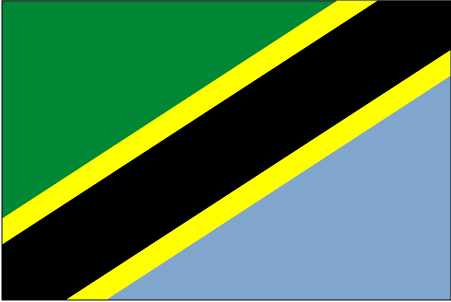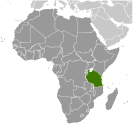
|
|
Advertisements:
EconomyEconomy - overview
Tanzania is one of the world's poorest economies in terms of per capita income, however, Tanzania averaged 7% GDP growth per year between 2000 and 2008 on strong gold production and tourism. The economy depends heavily on agriculture, which accounts for more than one-quarter of GDP, provides 85% of exports, and employs about 80% of the work force. The World Bank, the IMF, and bilateral donors have provided funds to rehabilitate Tanzania's aging economic infrastructure, including rail and port infrastructure that are important trade links for inland countries. Recent banking reforms have helped increase private-sector growth and investment, and the government has increased spending on agriculture to 7% of its budget. Continued donor assistance and solid macroeconomic policies supported a positive growth rate, despite the world recession. In 2008, Tanzania received the world's largest Millennium Challenge Compact grant, worth $698 million. Dar es Salaam used fiscal stimulus and loosened monetary policy to ease the impact of the global recession. GDP growth in 2009-11 was a respectable 6% per year due to high gold prices and increased production. Gdp (purchasing power parity) World Ranking: 85
$64.71 billion (2011 est.)
$60.66 billion (2010 est.) $56.94 billion (2009 est.) Note Data are in 2011 US dollars Gdp (official exchange rate)
$23.33 billion (2011 est.)
Gdp - real growth rate World Ranking: 35
6.7% (2011 est.)
6.5% (2010 est.) 6.7% (2009 est.) Gdp - per capita (ppp) World Ranking: 201
$1,500 (2011 est.)
$1,500 (2010 est.) $1,400 (2009 est.) Note Data are in 2011 US dollars Gdp - composition by sector
Agriculture 27.8%
Industry 24.2% Services 48% (2011 est.) Labor force World Ranking: 27
24.06 million (2011 est.)
Labor force - by occupation
Agriculture 80%
Industry and services 20% (2002 est.) Unemployment rate
NA%
Population below poverty line
36% (2002 est.)
Household income or consumption by percentage share
Lowest 10% 2.8%
Highest 10% 29.6% (2007) Distribution of family income - gini index World Ranking: 76
37.6 (2007)
34.6 (2000) Investment (gross fixed) World Ranking: 36
26.1% of GDP (2011 est.)
Budget
Revenues $4.603 billion
Expenditures $6.125 billion (2011 est.) Taxes and other revenues World Ranking: 164
19.7% of GDP (2011 est.)
Budget surplus (+) or deficit (-) World Ranking: 177
-6.5% of GDP (2011 est.)
Public debt World Ranking: 91
36.1% of GDP (2011 est.)
35% of GDP (2010 est.) Inflation rate (consumer prices) World Ranking: 202
12.7% (2011 est.)
7.2% (2010 est.) Central bank discount rate World Ranking: 94
8.25% (31 December 2010 est.)
3.7% (31 December 2009 est.) Commercial bank prime lending rate World Ranking: 45
14.96% (31 December 2011 est.)
14.55% (31 December 2010 est.) Stock of narrow money World Ranking: 99
$4.964 billion (31 December 2011 est.) $3.223 billion (31 December 2010 est.) Stock of broad money World Ranking: 112
$8.285 billion (31 December 2011 est.) $7.528 billion (31 December 2010 est.) Stock of domestic credit World Ranking: 115
$5.077 billion (31 December 2011 est.) $4.647 billion (31 December 2010 est.) Market value of publicly traded shares World Ranking: 104
$1.539 billion (31 December 2011) $1.264 billion (31 December 2010) $1.293 billion (31 December 2008) Agriculture - products
Coffee, sisal, tea, cotton, pyrethrum (insecticide made from chrysanthemums), cashew nuts, tobacco, cloves, corn, wheat, cassava (tapioca), bananas, fruits, vegetables; cattle, sheep, goats Industries
Agricultural processing (sugar, beer, cigarettes, sisal twine); mining (diamonds, gold, and iron), salt, soda ash; cement, oil refining, shoes, apparel, wood products, fertilizer Industrial production growth rate World Ranking: 41
7% (2010 est.)
Electricity - production World Ranking: 118
4.281 billion kWh (2008 est.)
Electricity - consumption World Ranking: 125
3.431 billion kWh (2008 est.)
Electricity - exports
0 kWh (2009 est.)
Electricity - imports
0 kWh (2008 est.)
Oil - production World Ranking: 138
0 bbl/day (2010 est.)
Oil - consumption World Ranking: 106
38,000 bbl/day (2010 est.)
Oil - exports World Ranking: 201
0 bbl/day (2009 est.)
Oil - imports World Ranking: 101
30,040 bbl/day (2009 est.)
Oil - proved reserves World Ranking: 199
0 bbl (1 January 2011 est.)
Natural gas - production World Ranking: 67
658 million cu m (2009 est.)
Natural gas - consumption World Ranking: 93
658 million cu m (2009 est.)
Natural gas - exports World Ranking: 192
0 cu m (2009 est.)
Natural gas - imports World Ranking: 132
0 cu m (2009 est.)
Natural gas - proved reserves World Ranking: 85
6.513 billion cu m (1 January 2011 est.) Current account balance World Ranking: 149
-$2.297 billion (2011 est.)
-$1.978 billion (2010 est.) Exports World Ranking: 113
$5.433 billion (2011 est.)
$4.297 billion (2010 est.) Exports - commodities
Gold, coffee, cashew nuts, manufactures, cotton Exports - partners
China 14.2%, India 9.9%, Japan 7.7%, Germany 6.7%, UAE 4.5% (2011) Imports World Ranking: 101
$8.65 billion (2011 est.)
$7.125 billion (2010 est.) Imports - commodities
Consumer goods, machinery and transportation equipment, industrial raw materials, crude oil Imports - partners
India 19.8%, China 17%, South Africa 6.5%, Kenya 5.8%, UAE 4.6% (2011) Reserves of foreign exchange and gold World Ranking: 99
$3.726 billion (31 December 2011 est.) $3.905 billion (31 December 2010 est.) Note Excludes goldDebt - external World Ranking: 96
$9.49 billion (31 December 2011 est.) $8.664 billion (31 December 2010 est.) Stock of direct foreign investment - at home
$NA
Stock of direct foreign investment - abroad
$NA
Exchange rates
Tanzanian shillings (TZS) per US dollar - 1,572.1 (2011 est.)1,409.3 (2010 est.) 1,320.3 (2009) 1,178.1 (2008) 1,255 (2007) Fiscal year
1 July - 30 June
Comments
Add a new comment: |
Advertisement
Members area
Tanzania (Dodoma):
 
GPS points from Tanzania (Dodoma)
|
||||||||

 Shortly after achieving independence from Britain in the early 1960s, Tanganyika and Zanzibar merged to form the nation of Tanzania in 1964. One-party rule ended in 1995 with the first democratic elections held in the country since the 1970s. Zanzibar's semi-autonomous status and popular opposition have led to two contentious elections since 1995, which the ruling party won despite international observers' claims of voting irregularities. The formation of a government of national unity between Zanzibar's two leading parties succeeded in minimizing electoral tension in 2010.
Shortly after achieving independence from Britain in the early 1960s, Tanganyika and Zanzibar merged to form the nation of Tanzania in 1964. One-party rule ended in 1995 with the first democratic elections held in the country since the 1970s. Zanzibar's semi-autonomous status and popular opposition have led to two contentious elections since 1995, which the ruling party won despite international observers' claims of voting irregularities. The formation of a government of national unity between Zanzibar's two leading parties succeeded in minimizing electoral tension in 2010.